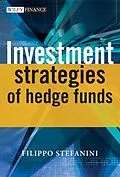One of the fastest growing investment sectors ever seen, hedge funds are considered by many to be exotic and inaccessible. This book provides an intensive learning experience, defining hedge funds, explaining hedge fund strategies while offering both qualitative and quantitative tools that investors need to access these types of funds. Topics not usually covered in discussions of hedge funds are included, such as a theoretical discussion of each hedge fund strategy followed by trading examples provided by successful hedge fund managers.
Autorentext
Filippo Stefanini is the Head of Research at Eurizon AI SGR where he is responsible for analysing, selecting and monitoring hedge funds and newcits funds. Eurizon AI SGR SpA is the alternative investment company of the banking group Intesa San Paolo and specialises in managing funds of hedge funds. He has been a lecturer in Risk Management at the University of Bergamo (Italy) since 2007. Filippo Stefanini was the Deputy Chief Investment Officer and Head of Asset Allocation at Aletti Gestielle Alternative SGR from 2001 to mid 2008. He previously worked as a consultant for Accenture in the Asset Management and Investment Banking areas. Filippo is the author of Investment Strategies of Hedge Funds and Newcits: Investing in UCITS Compliant Hedge Funds, both published by John Wiley & Sons. He has also co-authored some Italian language books published by Il Sole 24 Ore entitled I fondi newcits, Hedge Funds: strategie di investimento and Hedge Funds: Investire per generare rendimenti assoluti.
Klappentext
Since the first hedge fund was launched in 1949 by Alfred Winslow Jones, the industry has grown impressively. In 2005 it reached the record size of 1.3 trillion dollars and 8000 hedge funds. Responsible for a big slice of the daily trading volumes of financial markets, hedge funds are among the top clients for brokers, given the level of trading fees they generate.
The hedge fund world is a very heterogeneous one: there are hedge funds that encompass only a few people and those with trading floors bigger than soccer fields. The hedge fund world seems to be the place where the ability to generate positive uncorrelated returns resides, even though performances are not publicly disclosed.
And still, this remarkable phenomenon is surrounded by an aura of mystery. Using real-life examples and case studies, this book provides an intensive learning experience, and helps readers understand the investment strategies of hedge funds showing them how they can invest to make money in an uncorrelated way with financial markets.
Inhalt
Foreword xi
Preface xiii
Acknowledgments xvii
About the Author xix
1 A Few Initial Remarks 1
1.1 What is a hedge fund? 1
1.2 History of hedge funds 2
1.3 Proprietary trading 4
1.4 The growth of the hedge fund industry 4
1.5 Main characteristics of the current industry 6
1.6 Capacity 8
1.7 Commissions 8
1.8 Industry performance overview 9
1.9 The hedge fund manager 12
1.10 Alpha and beta 12
1.11 Investment strategies 13
1.12 Explorers and frontiers 16
1.13 SEC's vigilance 16
1.14 Considerations on performance sustainability 16
1.15 Capacity and performance sustainability 17
1.16 Ability or chance? 17
1.17 The importance of avoiding losses 18
1.18 Decreasing returns with longer investment horizons 19
1.19 Business case: A hedge fund start-up 19
2 Arbitrage 21
2.1 The transaction costs barrier 22
2.2 ADR arbitrage 23
2.3 Arbitrage between off-the-run and on-the-run thirty-year Treasury Bonds 24
3 Short Selling 27
3.1 A brief history of short selling 27
3.2 What is short selling? 30
3.3 A simplified example of short selling on US markets 31
3.4 Who lends securities for short selling? 32
3.5 Regulations governing short selling 33
3.6 The risks of short selling 34
3.7 Short interest and short interest ratio 35
3.8 Wall Street's alter ego 36
3.9 Stock picking in short selling 37
3.10 The art of contrary thinking 41
3.11 Measuring the strategy's historical performance 42
3.12 Conclusions 45
4 Long/Short Equity 47
4.1 History of the first hedge fund 48
4.2 Market exposure 48
4.3 Management styles 52
4.4 Specialized long/short equity funds 55
4.4.1 Long/short equity technology-media-telecommunication (TMT) 56
4.4.2 Long/short equity biotech 57
4.4.3 Long/short equity gold 58
4.4.4 Long/short equity on emerging markets 58
4.5 Share class arbitrage 62
4.6 Pairs trading 62
4.7 Covered call and covered put options sale 64
4.8 Strategy's historical performance analysis 65
4.9 Equity market neutral 69
4.9.1 Equity market neutral strategy's historical performance analysis 70
5 Merger Arbitrage 75
5.1 A brief history of M&A 76
5.2 Strategy description 82
5.3 Risk associated with the outcome of an extraordinary corporate event 83
5.4 Types of mergers and acquisitions 86
5.4.1 Cash mergers or tender offers 86
5.4.2 Stock swap mergers or stock-for-stock mergers 87
5.4.3 Stock swap mergers with a collar 89
5.4.4 Multiple bidder situations 90
5.4.5 Leveraged buyouts and hostile takeovers 90
5.4.6 Spin-offs 92
5.5 Risk management 92
5.6 Strategy's historical performance analysis 93
5.7 Conclusions 96
6 Convertible Bond Arbitrage 99
6.1 Why issue a convertible bond? 101
6.2 A brief history of convertible bonds 101
6.3 The convertible bond market 102
6.4 Definitions 106
6.5 Quantitative models to value convertible bonds 107
6.5.1 Analytical models 108
6.5.2 Numerical models 109
6.6 Implied volatility and historical volatility 110
6.6.1 Credit spreads, implied volatility and risk appetite 110
6.7 Convertible bond arbitrage 110
6.7.1 Cash-flow arbitrage 111
6.7.2 Volatility trading 113
6.7.3 Gamma trading 117
6.7.4 Credit arbitrage 120
6.7.5 Skewed arbitrage 124
6.7.6 Carry trade 124
6.7.7 Refinancing plays 126
6.7.8 Late stage restructuring plays 126
